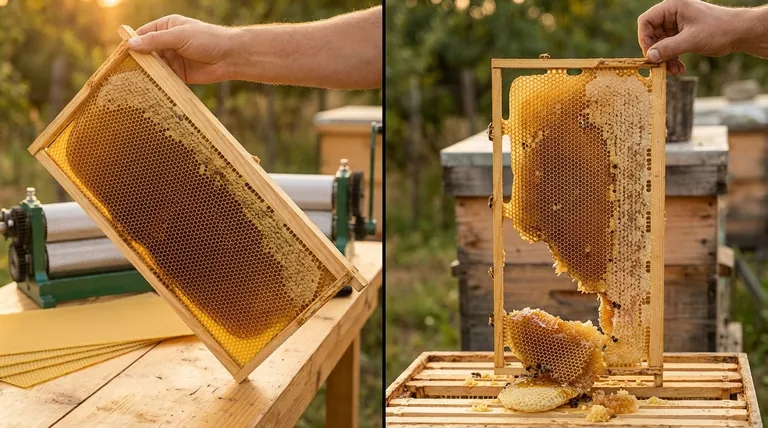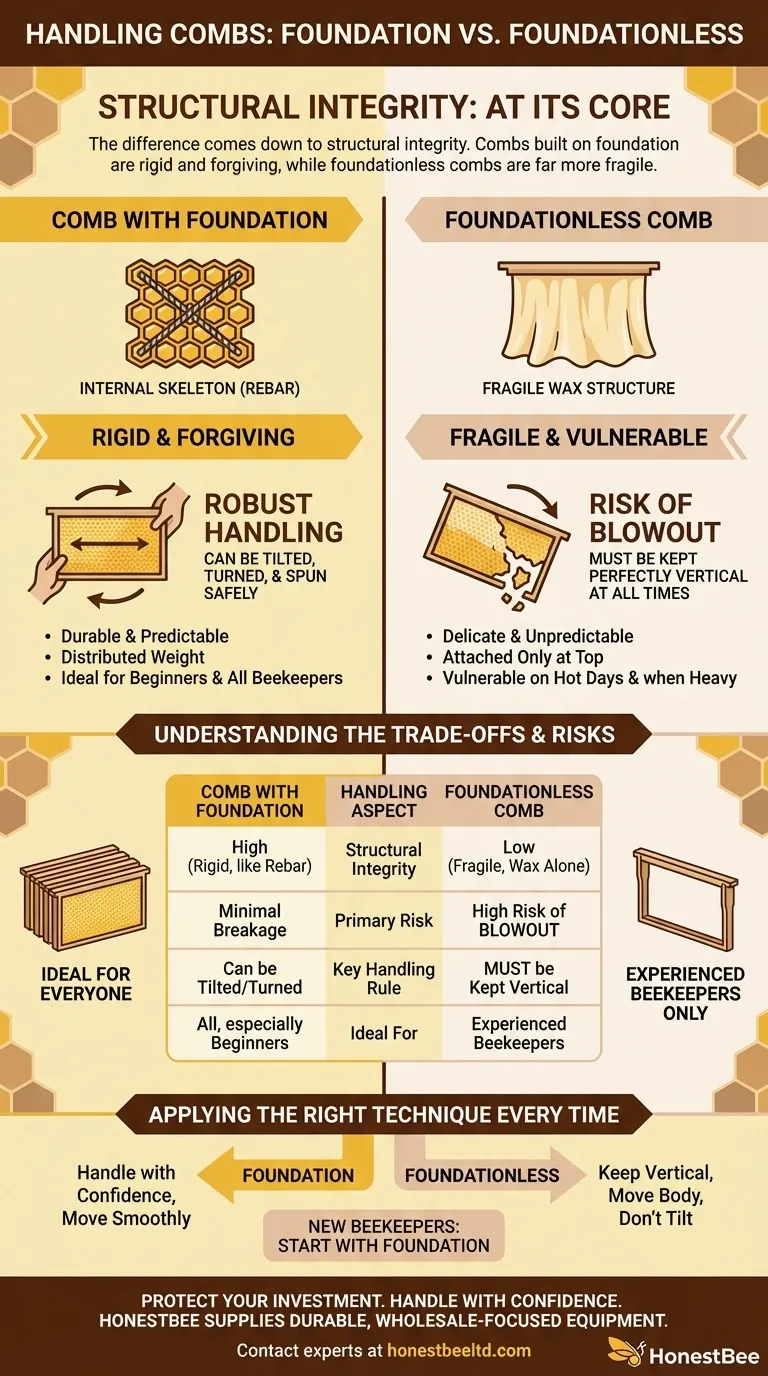At its core, the difference comes down to structural integrity. Combs built on foundation are rigid and forgiving, while foundationless combs are far more fragile and demand specific, careful handling to prevent them from breaking under their own weight.
The presence of a foundation sheet fundamentally changes a comb's strength. It acts as an internal skeleton, allowing for robust handling, whereas a foundationless comb relies solely on the wax structure created by the bees, making it vulnerable to collapse if not kept perfectly vertical.

The Role of Foundation: A Structural Backbone
The use of foundation is the most common practice in modern beekeeping precisely because it makes hive management more predictable and frames more durable.
What is Foundation?
Foundation is a thin sheet, typically made of beeswax embossed with a honeycomb pattern or food-grade plastic, that is inserted into a hive frame. It provides a guide and a structural base for the bees to build their wax comb upon.
Why It Creates a Stronger Comb
Think of foundation as rebar in concrete. It provides immense tensile strength and a rigid core. The wax the bees build is fully supported and bonded to this central sheet, distributing the weight of honey, pollen, and brood across the entire frame.
Handling a Comb with Foundation
Because of this internal support, a comb built on foundation can be handled with confidence. You can turn it, tilt it horizontally to inspect larvae, and even spin it at high speeds in a honey extractor without fear of it disintegrating.
The Nature of a Foundationless Comb
Foundationless beekeeping is a method chosen for various reasons, including allowing bees to determine their own cell size. However, it requires a more skilled and gentle approach.
Building on Air
With a foundationless frame, the bees are given only a narrow guide on the top bar. From there, they must construct the entire comb structure from scratch, hanging it down like a delicate curtain of wax.
The Source of Fragility
A foundationless comb is attached only at the top and sometimes lightly to the side bars. Its entire structural integrity depends on the strength of that wax connection. On a hot day, wax softens. When combined with the immense weight of stored honey, the comb can easily tear away from the frame if mishandled.
The Correct Handling Technique
To prevent a "blowout," you must always keep the forces of gravity aligned with the comb's strongest axis. Hold the frame perfectly vertical at all times, as if it were a page in a book.
If you need to inspect the other side, do not tilt the frame. Instead, keep the frame upright and turn your own body, or rotate the frame vertically as you would turn a page, always keeping it perpendicular to the ground.
Understanding the Trade-offs and Risks
Choosing between foundation and foundationless methods involves a clear trade-off between durability and other beekeeping goals.
The Risk of a "Blowout"
The primary risk of mishandling a foundationless comb is a blowout. This is when the comb breaks off the frame, falls to the bottom of the hive, and creates a catastrophic mess of honey, broken brood, and crushed bees. It's a significant setback for the colony.
When Combs Are Most Vulnerable
Foundationless combs are most at risk under three conditions:
- When they are new: Freshly built white wax is softer and weaker.
- On hot days: Ambient heat softens the wax, drastically reducing its strength.
- When they are heavy: A frame full of honey can weigh over eight pounds, putting immense stress on the wax attachments.
Applying the Right Technique Every Time
Your handling method must adapt to the type of comb you are inspecting. Internalizing this discipline is critical for responsible hive management.
- If you are working with foundation combs: You can handle them with confidence and flexibility, but always move smoothly to avoid disturbing the bees.
- If you are inspecting foundationless combs: Always keep the frame vertical. Move your body around the frame rather than tilting the frame itself.
- If you are a new beekeeper: Starting with foundation is highly recommended to build confidence in handling frames before attempting the more delicate foundationless method.
Mastering the proper handling technique for each comb type is fundamental to successful and minimally disruptive beekeeping.
Summary Table:
| Handling Aspect | Comb with Foundation | Foundationless Comb |
|---|---|---|
| Structural Integrity | High (rigid, like rebar in concrete) | Low (fragile, relies on wax alone) |
| Primary Risk | Minimal risk of breakage | High risk of "blowout" if mishandled |
| Key Handling Rule | Can be tilted or turned horizontally | Must be kept perfectly vertical at all times |
| Ideal For | All beekeepers, especially beginners | Experienced beekeepers seeking natural cell size |
Protect your investment and handle every frame with confidence. Whether you manage commercial apiaries or distribute beekeeping equipment, using the right supplies is key to hive health and productivity. HONESTBEE supplies durable, wholesale-focused beekeeping supplies and equipment—including robust foundations and frames designed for secure handling. Contact our experts today to discuss your specific needs and ensure your combs remain intact season after season.
Visual Guide

Related Products
- Manual Beeswax Comb Foundation Machine Wax Foundation Mill Embossing Machine
- Electric Beeswax Foundation Machine With Operating Tray and Wax Foundation Roller
- Colorful Silicone Beeswax Foundation Mold Mould for Beekeeping
- Electric Flatting and Embossing Machine with Tray for Beekeeping
- Beeswax Foundation Sheets Beehive Foundation for Wholesale
People Also Ask
- How do honeybees use wax in their hives? The Key to Colony Survival and Structure
- What is the use of a comb foundation mill? Boost Honey Production with Strategic Hive Control
- What texture is embossed on the beeswax foundation machine? The Precise Worker Bee Cell Pattern for Hive Efficiency
- What is a comb foundation mill? A Strategic Tool for Stronger, More Productive Hives
- What is wax foundation made of? The Essential Guide to Pure Beeswax Foundations
















